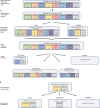Therapies for Genetic Forms of Parkinson's Disease: Systematic Literature Review
- PMID: 33459660
- PMCID: PMC8203229
- DOI: 10.3233/JND-200598
Therapies for Genetic Forms of Parkinson's Disease: Systematic Literature Review
Abstract
Parkinson's disease (PD) is a disabling neurological condition characterized by the loss of dopaminergic neurons. Currently, the treatment for PD is symptomatic and compensates for the endogenous loss of dopamine production. In cases where the pharmacological therapy is only partly beneficial or results in major wearing-off complications, surgical interventions such as deep brain stimulation may be an alternative treatment. The disease cause often remains unknown, but in some patients, a monogenic cause can be identified. Mutations in at least six genes, LRRK2, SNCA, and VPS35 (dominant forms) or Parkin/PRKN, PINK1, and DJ1/PARK7 (recessive forms) have been unequivocally linked to PD pathogenesis. We here systematically screened 8,576 publications on these monogenic PD forms. We identified 2,226 mutation carriers from 456 papers. Levodopa was the most widely applied treatment; only 34 patients were indicated to be untreated at the time of reporting. Notably, detailed treatment data was rarely mentioned including response quantification (good, moderate, minimal) in 951 and/or dose in 293 patients only. Based on available data, levodopa showed an overall good outcome, especially in LRRK2, VPS35, Parkin, and PINK1 mutation carriers ("good" response in 94.6-100%). Side effects of levodopa therapy were reported in ∼15-40%of levodopa-treated patients across genes with dyskinesias as the most frequent one. Non-levodopa medication was indicated to be administered to <200 patients with mainly good outcome. Only a few reports were available on outcomes of brain surgery. Here, most mutation carriers showed a good response. Importantly, none of the available treatments is harmful to one genetic form but effective in another one. In the light of different medication schemes, the progressive nature of PD, and side effects, an improvement of therapeutic options for PD is warranted including a treatabolome database to guide clinicians in treatment decisions. Further, novel disease-cause-modifying drugs are needed.
Keywords: MDSGene; Treatabolome; deep brain stimulation; genetic Parkinson’s disease; levodopa; systematic literature review; treatment.
Conflict of interest statement
The authors do not have any conflict of interest.
N.B. served as a consultant for Centogene. NB is funded by the DFG (BR4328.2-1/2-2, GRK1957), the Collaborative Center for X-linked Dystonia-Parkinsonism and the Else-Kröner Fresenius-Stiftung (HA17_2017).
K.L. received funding from the German Research Foundation, the International Parkinson’s disease and Movement Disorder Society (MDS), and the Damp foundation. She is further an active member of the Global Parkinson’s Genetics Program (GP2) initiative.
Figures







References
-
- Obeso JA, Stamelou M, Goetz CG, Poewe W, Lang AE, Weintraub D, Burn D, Halliday GM, Bezard E, Przedborski S, Lehericy S, Brooks DJ, Rothwell JC, Hallett M, DeLong MR, Marras C, Tanner CM, Ross GW, Langston JW, Klein C, Bonifati V, Jankovic J, Lozano AM, Deuschl G, Bergman H, Tolosa E, Rodriguez-Violante M, Fahn S, Postuma RB, Berg D, Marek K, Standaert DG, Surmeier DJ, Olanow CW, Kordower JH, Calabresi P, Schapira AHV, Stoessl AJ. Past, present, and future of Parkinson’s disease: A special essay on the 200th Anniversary of the Shaking Palsy. Mov Disord. 2017;32:1264–310. - PMC - PubMed
-
- Fox SH, Katzenschlager R, Lim SY, Barton B, de Bie RMA, Seppi K, Coelho M, Sampaio C, Movement Disorder Society Evidence-Based Medicine C. International Parkinson and movement disorder society evidence-based medicine review: Update on treatments for the motor symptoms of Parkinson’s disease. Mov Disord. 2018;33:1248–66. - PubMed
-
- Armstrong MJ, Okun MS. Diagnosis and Treatment of Parkinson Disease: A Review. JAMA. 2020;323:548–60. - PubMed
-
- Bronstein JM, Tagliati M, Alterman RL, Lozano AM, Volkmann J, Stefani A, Horak FB, Okun MS, Foote KD, Krack P, Pahwa R, Henderson JM, Hariz MI, Bakay RA, Rezai A, Marks WJ Jr, Moro JL, Vitek A, Weaver FM, Gross RE, DeLong MR. Deep brain stimulation for Parkinson disease: An expert consensus and review of key issues. Arch Neurol. 2011;68:165. - PMC - PubMed
-
- Domingo A, Klein C. Genetics of Parkinson disease. Handb Clin Neurol. 2018;147:211–27. - PubMed
Publication types
MeSH terms
Substances
LinkOut - more resources
Full Text Sources
Other Literature Sources
Medical
Miscellaneous

